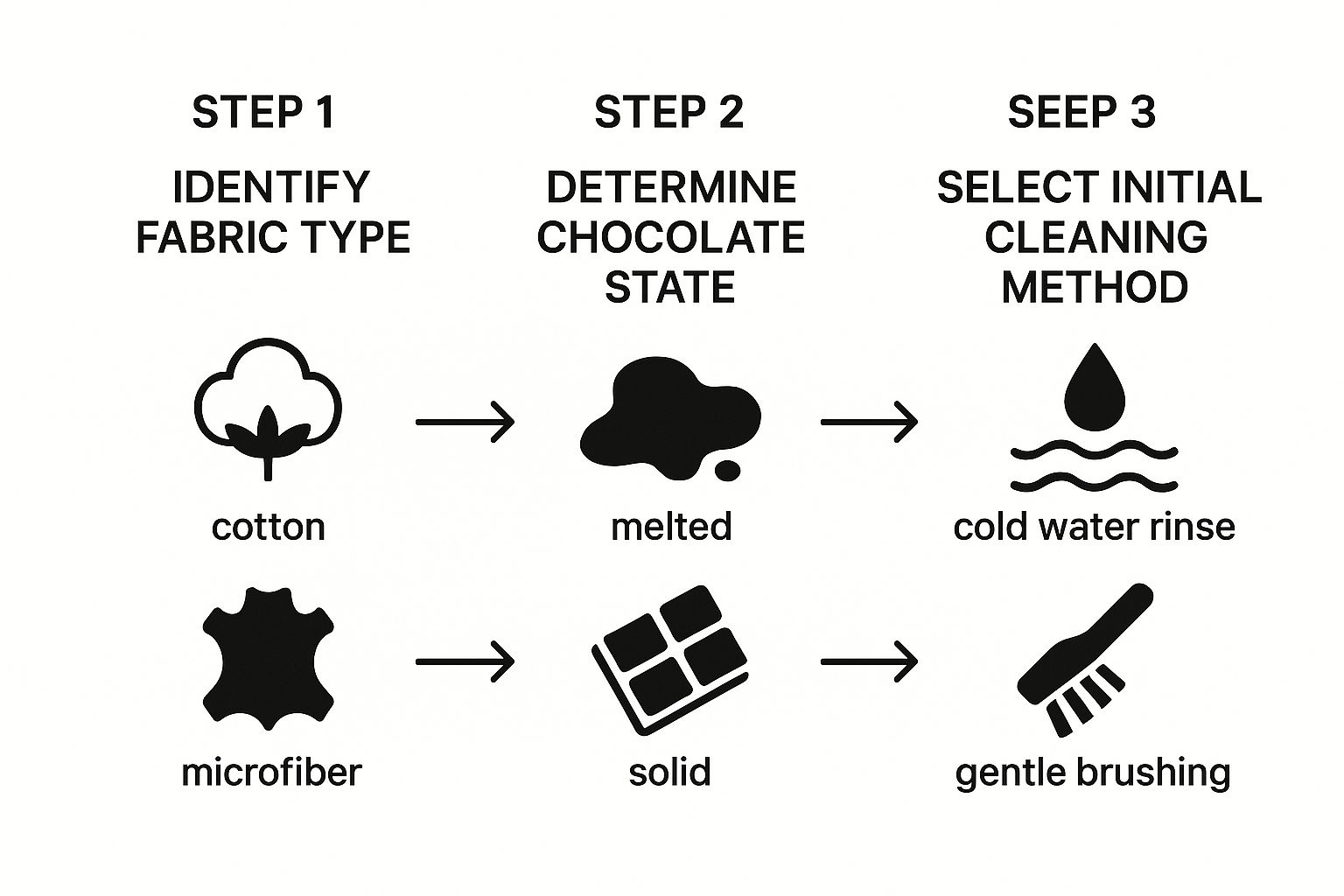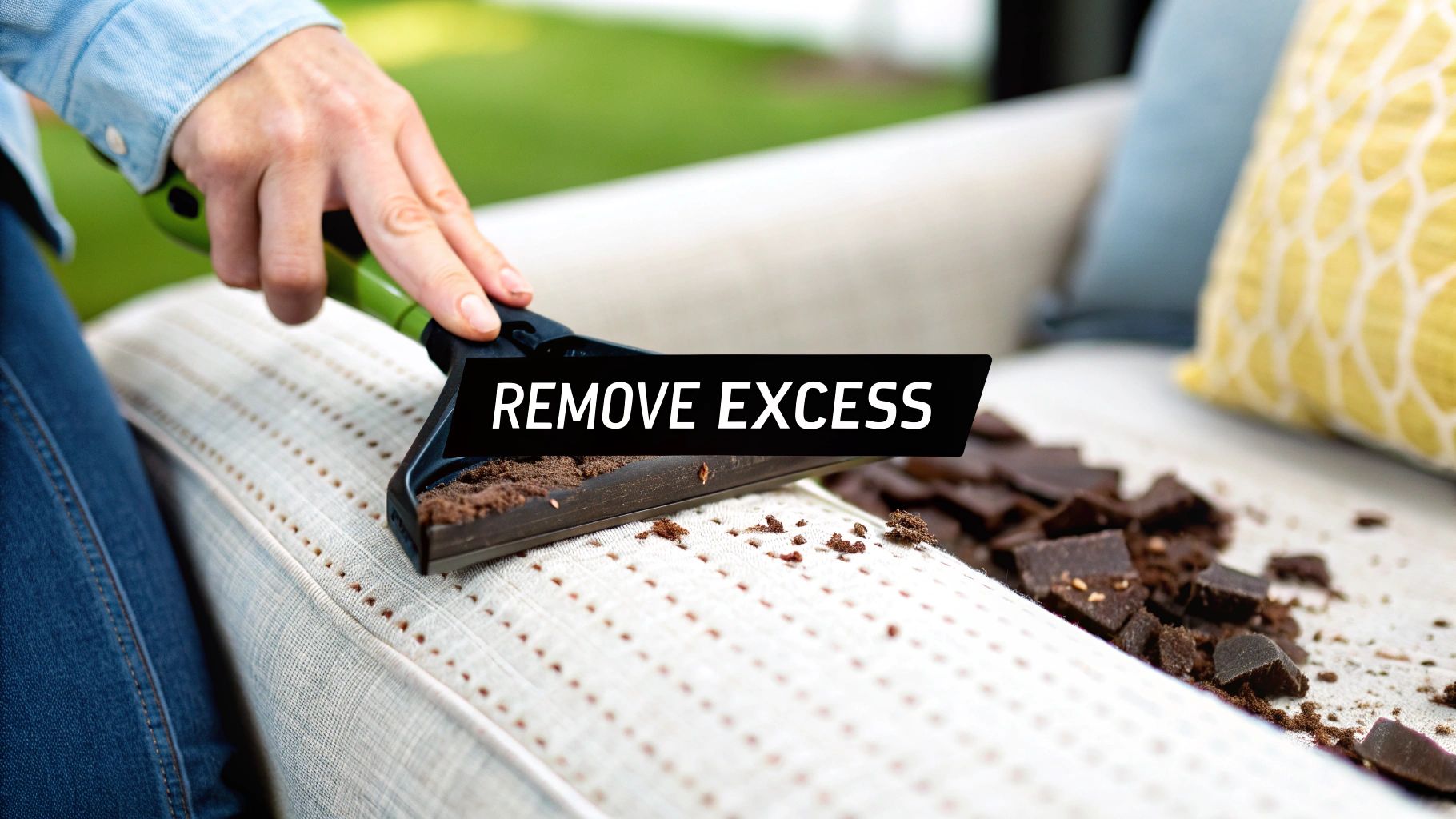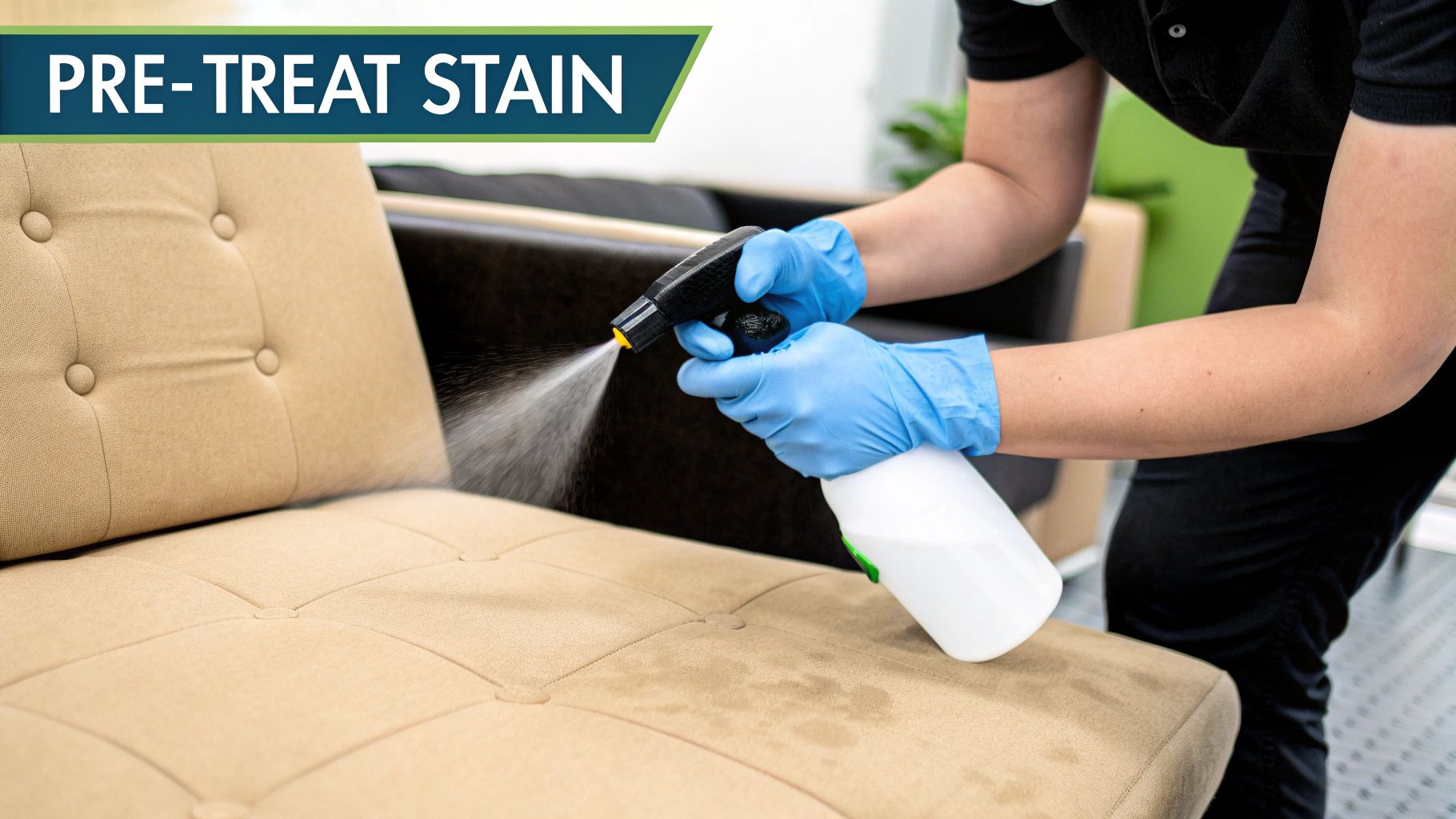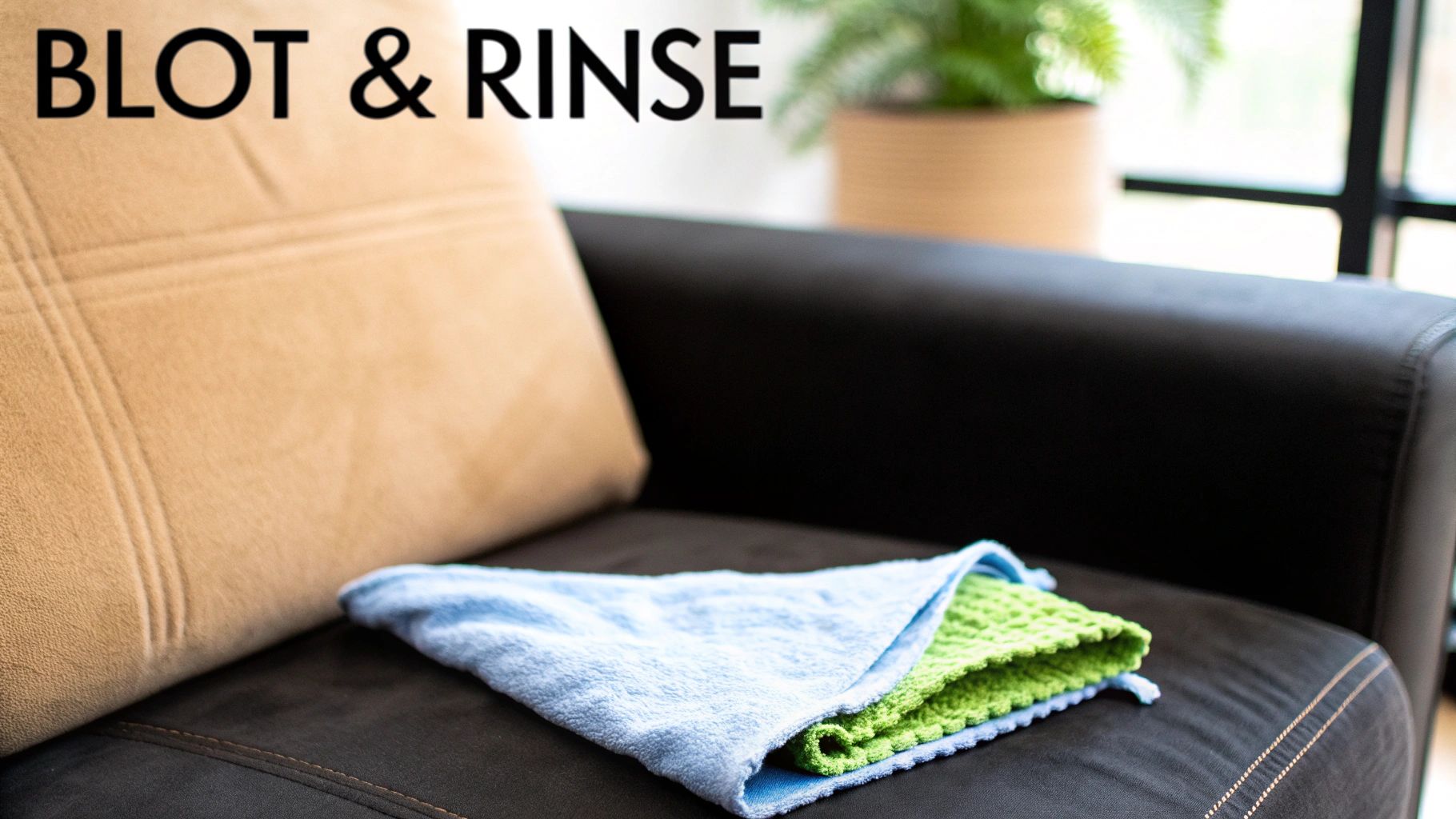The key to getting chocolate out of upholstery is to move fast: scrape off any solid bits first, then gently blot the spot with a cold, damp cloth. Whatever you do, avoid rubbing or using hot water. Heat will only melt the chocolate's fats and cook its proteins right into the fabric, setting the stain for good.
Your Immediate Action Plan for Chocolate Spills
We’ve all been there—that heart-stopping moment when a piece of chocolate lands on your favorite armchair. But a quick reaction can keep it from becoming a permanent mark. What you do in those first few minutes is everything. The goal is simple damage control, stopping the mess before it works its way deep into the upholstery fibers.
Chances are, you already have everything you need to tackle this. Before starting, it’s a good idea to gather your supplies so you’re not scrambling mid-cleanup. For a full rundown of what to keep in your cleaning caddy, check out our basic cleaning supplies checklist.
Gather Your Tools First
Before you even touch the stain, get your toolkit ready. Having everything within arm's reach makes the entire process smoother and keeps you from making a bigger mess.
Your Chocolate Stain Removal Toolkit
Gather these common household items before you start. Having everything ready makes the process faster and more effective.
| Tool or Solution | Why You Need It | Pro Tip |
|---|---|---|
| Butter Knife or Spoon | For scraping off excess solid chocolate without snagging the fabric. | A credit card or plastic scraper also works in a pinch. |
| Clean White Cloths | To blot the stain without transferring any color onto the upholstery. | Microfiber cloths are great because they're super absorbent. |
| Cold Water | Helps break down the stain without setting it like hot water would. | Keep a small bowl of cold water nearby for easy access. |
| Mild Dish Soap | A gentle degreaser that lifts the fats in the chocolate. | Use a clear, dye-free dish soap to avoid adding more color. |
Once you have these items, you're ready to get to work. Remember, patience is just as important as the tools you use.
What to Do in the First 60 Seconds
Your first move isn't cleaning—it's assessing the situation. Is the chocolate melted or solid? What kind of fabric are you dealing with? These factors will determine your next step.
This visual guide breaks down exactly what to do based on the type of chocolate and your upholstery.

As you can see, figuring out these key details first helps you choose the right approach and prevents you from accidentally making things worse. A melted smudge on velvet needs a different touch than a solid chunk on durable microfiber.
The Scrape and Blot Method
Successful chocolate removal always starts with two simple actions: scraping and blotting.
First, take a dull edge—like a butter knife or the side of a spoon—and carefully lift off as much of the solid chocolate as you can. Be gentle! The goal is to remove the excess without pushing it further into the weave.
Next, you blot. Take a clean, dry cloth and press it gently onto the remaining stain. Never, ever rub. Rubbing just grinds the stain deeper into the fabric, making it a nightmare to get out later.
Decoding Your Furniture's Cleaning Codes

Before you even think about mixing a cleaning solution, you need to play detective for a minute. Your furniture has a secret it's dying to tell you, and it’s usually hidden on a small tag under a cushion or on the frame. This tag has a single, crucial letter on it—the manufacturer's cleaning code.
Trust me, ignoring this code is the fastest way to turn a small chocolate smudge into a permanent, heartbreaking disaster. These letters aren't suggestions; they're the non-negotiable rules for your specific fabric. They tell you exactly what you can (and absolutely cannot) use to clean it safely.
Understanding the Codes
Think of these letters as your cheat sheet for avoiding a costly mistake. Each one spells out a very specific cleaning method.
- W: This is the one you’re hoping for. It means you can safely use water-based cleaners. This is the most common code and allows for gentle solutions made with water and a bit of mild soap.
- S: This code stands for solvent-based cleaners only. Water is the enemy here. I’ve seen beautiful fabrics ruined because someone used a damp cloth on an 'S' code—it often leaves a permanent water ring that looks even worse than the original stain.
- W/S: This gives you options. You can use either a water-based or a solvent-based cleaner, which offers a lot more flexibility when tackling a stain.
- X: This is the most delicate of all. It means vacuum only. Don't even think about using water or solvents on this fabric. If you have an 'X' code fabric with a chocolate stain, your only safe bet is to call a professional.
The most common mistake I see is people assuming all fabrics can handle a simple soap and water solution. Using water on an 'S' code velvet, for instance, can crush the pile and leave a watermark that is impossible to remove. Seriously, always check the tag first.
Getting to know your furniture goes beyond just cleaning codes. A deeper awareness, including understanding the different types of furniture and their functions, such as what is a sofa table, helps you create a more cohesive and functional living space.
Once you’ve found your code, you can move forward with confidence. For detailed, step-by-step instructions on what to do next, check out our complete guide on how to clean upholstery couches.
Practical DIY Cleaning Solutions That Work

Alright, let's get our hands dirty—or, rather, clean. You really don't need a cabinet full of expensive, specialized products to tackle most chocolate stains. In fact, a couple of common household items can create a powerful cleaning solution that’s safe for most fabrics, especially anything with a "W" cleaning code.
The real trick is knowing which solution to use and when. A fresh, gooey chocolate fingerprint on a durable microfiber couch calls for a different game plan than a small, week-old smudge on a delicate cotton armchair. I'll walk you through crafting two simple, yet shockingly effective, homemade solutions so you can clean with confidence.
The Gentle Dish Soap Solution
For fresh spills and most common upholstery types, your first line of defense is a simple mix of clear dish soap and cold water. It sounds basic, but dish soap is a fantastic degreaser, which is exactly what you need to break down the fats and oils hiding in that chocolate stain.
Here’s how to mix and use it the right way:
- Create the Solution: Mix one teaspoon of clear, dye-free dish soap into two cups of cold water. Stir it gently—you want to combine it without creating a bubble bath.
- Apply and Blot: Dip a clean, white microfiber cloth into your solution and wring it out well. It should be damp, not dripping wet. Gently blot the stain, working from the outside edges inward to keep it from spreading.
- Rinse Lightly: Grab a second clean cloth, dampen it with plain cold water, and blot the area again. This "rinses" away any lingering soap residue.
- Blot Dry: Finally, press a dry cloth or a stack of paper towels firmly onto the spot to soak up as much moisture as you can.
This method works wonders on fresh stains. Picture this: a chocolate candy melts onto your polyester-blend sofa during movie night. This gentle solution is likely all you'll need to lift it right out without harming the fabric.
The Vinegar Solution for Stubborn Stains
What if the stain has had a little more time to settle in? Or if the dish soap mix just isn't quite cutting it? Adding white vinegar can provide the extra muscle you need. Vinegar is a mild acid that helps dissolve tannins—the natural compounds that give chocolate its dark, stubborn color.
For this more potent cleaner, just mix one tablespoon of white vinegar and one teaspoon of dish soap into two cups of cold water. Apply it using the same careful blotting technique I described above.
Always remember to spot-test any cleaning solution, especially one with vinegar, on a hidden part of the upholstery first. A spot under a cushion or on the back of the furniture is perfect. This quick check ensures it won't cause any discoloration or damage.
Not sure which cleaner is right for your situation? This quick table breaks it down.
Which DIY Solution Should You Use?
A quick comparison to help you choose the right cleaner for your specific stain and fabric type.
| DIY Solution | Best For Upholstery Code | Ideal Stain Type | Important Cautions |
|---|---|---|---|
| Dish Soap & Water | W, W/S | Fresh, oily, or greasy chocolate stains | Use clear, dye-free soap to avoid color transfer. Don't oversaturate the fabric. |
| Vinegar & Dish Soap | W, W/S (with caution) | Older, set-in, or dark chocolate stains | Always spot-test in a hidden area first, as vinegar can affect some dyes. |
By matching the solution to the stain’s age and your upholstery type, you can handle most chocolate-related mishaps like a pro.
Tackling Tough Set-In Chocolate Stains

Finding a chocolate stain that’s been sitting for days can feel like a real “uh-oh” moment. Don't throw in the towel just yet. Even old, dried-on stains can usually be dealt with if you have the right strategy.
The real challenge with old chocolate stains is that the fats and oils have had time to bond tightly with the fabric fibers. This makes them way more stubborn than a fresh spill. That’s why a good pre-treatment is your secret weapon.
Before you reach for any liquid cleaner, you have to deal with those locked-in oils first. A simple absorbent powder from your pantry is perfect for this.
- Baking Soda: Just sprinkle a generous amount right on top of the dried stain. It’s fantastic at drawing the oils out from deep within the upholstery.
- Cornstarch: This works just like baking soda, acting like a magnet for all that greasy residue hiding in the stain.
Let the powder sit for about 15-20 minutes. Give it some time to work its magic and soak up those oils. After that, grab your vacuum and use a brush attachment to suck all the powder away. You’d be surprised how much this one step can break down the stain before you even start the real cleaning.
Adjusting for Different Upholstery Materials
Not all fabrics are created equal, and using the wrong cleaning method can spell disaster for delicate materials. When you’re trying to get set-in chocolate out of upholstery, the type of fabric will tell you what to do next.
A tough synthetic blend like microfiber, for example, can usually handle a water-based cleaner just fine after you’ve done the powder pre-treatment. You can go ahead and use the vinegar solution we talked about earlier, applying it gently with a cloth.
But delicate fabrics need a much lighter touch. Velvet is famously tricky with water—it can crush the pile and leave permanent marks. If you're working with velvet or any fabric with an "S" cleaning code, a solvent-based upholstery cleaner is a much safer bet. Just be sure to test it on a hidden spot first.
The biggest mistake people make with set-in stains is getting impatient. They start scrubbing too hard or reaching for harsh chemicals out of frustration, which only ends up damaging the fabric. A gentle pre-treatment followed by the right cleaner for your specific fabric is the real key to success.
Knowing how to handle different fabrics is a must-have skill for any homeowner. For a deeper dive into stain removal on all kinds of surfaces, our guide on how to remove stains from carpets and upholstery has more expert advice. By matching your technique to the textile, you can tackle even the most intimidating dried chocolate stains.
Knowing When To Call a Professional Cleaner
Sometimes, even the best DIY efforts just won't cut it. Knowing your limits is the smartest way to protect your furniture and avoid turning a small chocolate spot into a costly disaster. Recognizing when to call for backup isn’t admitting defeat—it’s just being smart.
So, when is it time to hand it over to the experts? There are a few clear signs that you’re dealing with a bigger problem than a homemade solution can handle.
The Warning Signs
You should seriously consider calling a professional upholstery cleaner if you run into any of these issues:
- The Stain Spreads: Your careful blotting has only made the chocolate stain larger and muddier.
- A Water Ring Appears: After your cleaning attempt dries, a distinct outline or ring is now visible around the original spot.
- The Fabric is Delicate: You’re working with tricky materials like silk, velvet, suede, or anything with an “S” or “X” cleaning code. Don't risk it.
- The Furniture is an Antique: Vintage pieces often have fragile dyes and fibers that require a specialist's touch to avoid permanent damage.
Professional cleaners bring specialized, fabric-safe solvents and powerful hot water extraction equipment that can lift deep-set stains without leaving that dreaded residue behind. It's no surprise the upholstery cleaning market is projected to hit $83.5 billion by 2030. People know when to call in the pros for tough jobs.
And hey, if after trying everything the upholstery is just too far gone, you might eventually need a good guide to sofa disposal. It happens.
Answering Your Top Chocolate Stain Questions
When you're dealing with a chocolate catastrophe, a few questions always seem to pop up. Let's clear up some of the common myths and make sure you have the right info to tackle that stain with confidence.
Can I Use Hot Water on a Chocolate Stain?
That’s a hard no. In fact, it's probably the most critical rule to remember when you're learning how to remove chocolate from upholstery. You must always start with cold water.
Hot water will do the opposite of what you want—it can actually "cook" the proteins and fats right into the fabric. Once that happens, the stain bonds with the fibers, making it nearly impossible to remove.
Does Club Soda Actually Work?
I've heard the club soda trick a thousand times, and while it has a reputation as a miracle cleaner, it’s not your best bet here.
The fizz might lift a tiny, brand-new smudge, but chocolate is a complex, greasy stain. It needs a real detergent to properly break down all the oils and sugars clinging to your upholstery. Save the club soda for a wine spill.
Always check your upholstery's cleaning code. An "X" code is a serious warning—it means you can't use water or any solvent-based cleaners. For these delicate fabrics, you're limited to vacuuming or gently brushing away debris. A chocolate stain on "X" code fabric means it's time to call in a professional upholstery cleaner, period.
If you've tried everything and that stubborn stain just won't give up, or you'd simply rather leave it to the experts, Custom Maids is here to help. Our team has the professional tools and know-how to safely restore your furniture. Visit us at https://custom-maids.co to schedule a consultation.

